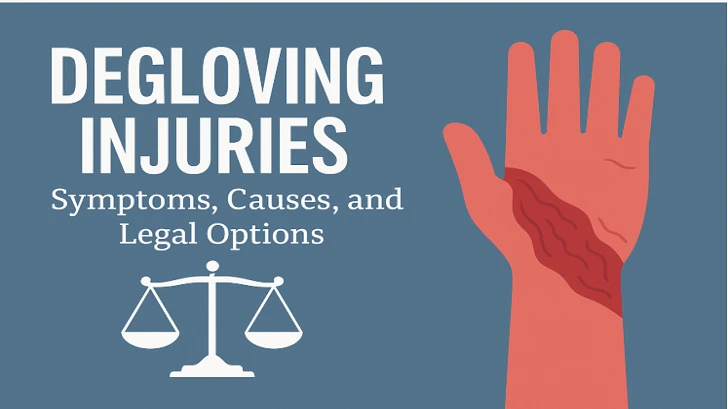- Author: Richard Stim
- Jun 11, 2025
Degloving injuries are rare but extremely serious. These types of injuries are capable of inflicting severe damage, such as disfigurement, loss of nerves, and, in some cases, even amputation.
A degloving injury can lead to permanent impairment. A person might develop medical complications that not only increase treatment expenses but also hinder the ability to gainfully engage in employment.
What is a Degloving Injury?
A degloving injury is a traumatic injury that tears the top layers of skin and tissues from the connecting bones, underlying muscle, or tissues. It occurs as if a glove is removed. Fundamentally, it affects the legs and will frequently cause fractures in underlying tissues. Deglove injuries can also be life-threatening.
These injuries commonly occur in machinery accidents, such as in industrial settings or motor vehicle accidents, where significant force or crushing injuries are involved.
Causes Of Degloving Injuries
There may be several causes of degloving injuries. Some common causes of degloving injuries include:

- Car accidents
- Motorcycle crashes
- Truck wrecks
- Sports mishap
- Ring degloving injury
- Animal bites
- Falling from heights
- Workplace accidents
- Construction sites
There may be various other situations in which degloving injuries can happen. Therefore, you must be aware of the surroundings and take the necessary steps to prevent causing such a dreadful injury. It is advisable to wear protective gear as one of the preventive measures.
Symptoms of Degloving Injury
Symptoms of a degloving injury, which is a severe type of soft tissue injury, include
- Severe skin tearing
- Heavy bleeding
- Swelling and bruising
- Exposed structures
- Severe pain
- Numbness or loss of function
- Skin discoloration or dead tissue
- Open wound with high risk of infection
Types Of Degloving Injuries
Degloving injuries can be categorized into two main types:
-
Open degloving injury: If there is ripping of the muscles, bones, and skin, an open degloving injury may occur, thereby exposing them. When the injury is caused, the skin may hang as a flap or remain partially attached.
-
Closed degloving injury: This type of injury is more complicated because the topmost layer of the skin will remain intact, whether it separates from the tissues below it or not.
-
Partial Degloving Injury: In a partial degloving injury, some of the skin and tissue are torn away, but they remain partially attached to the body. In this case, some blood flow can reach the area, which may improve the chances of healing.
-
Complete Degloving Injury: In a complete degloving injury, the skin, as well as underlying tissue, is separated completely from the body, exposing underlying muscles, bones, or tendons. This type is more severe and usually requires some surgical intervention and skin grafts.
Side Effects Of Avulsion Injuries
Degloving injuries, popularly known as avulsion injuries, may cause the following side effects:
-
Avulsion injuries may be severe, causing wrongful death and resulting in wrongful death claims. The tissues may disappear due to severe damage, which may result in a low oxygen supply to the body.
-
At times, degloving injuries may lead to infections if the wounds are left open.
-
In extreme cases, degloving injuries may cause amputations when body parts cannot be healed.
-
If the injuries are causing numbness, loss of temperature sensitivity, and intense pain, thereby leading to patient discomfort.
-
Degloving injuries may lead to scars, and in the case of skin transplant chances of scarring are maximum.
How Long Does a Degloving Injury Take To Heal?
The healing time for a degloving injury may vary depending on the severity of the injury, the specific area affected, and individual factors. Generally, degloving injuries require extensive medical treatment and can take several weeks to months to heal fully. The healing process may involve surgeries, skin grafts, wound care, and rehabilitation.
Medical Treatment For Serious Degloving Injuries
Subsequent stages of healing involve rebuilding and restoring the affected area. This may include surgical procedures such as
- Skin grafting
- Reconstructive surgery
- Reattachment of fingers and toes
- Physical therapy to regain function and mobility
If someone has sustained a closed type of degloving injury, they can use the therapies and bandages that may be essential. However, in severe cases, fluid may be drained from the wound, which will help to get rid of dead tissue. Sometimes, injections are also used to shrink blood vessels to provide relief for the victim.
How Does a Degloving Injury Differ From Other Types Of Injuries?
A degloving injury differs from other types of injuries primarily in its nature and severity.
-
Skin and tissue detachment: In a degloving injury, a large area of skin and underlying tissue is forcefully separated from the underlying structures. This results in the removal or separation of the skin, exposing the underlying structures like muscles, tendons, and bones.
-
Extensive damage: Degloving injuries often involve significant trauma and can cause extensive damage to the affected area. They may result in severe tissue loss and damage to blood vessels, nerves, and other vital structures, making them more complex and challenging to treat.
-
Potential for complications: Due to the severity of the injury and the involvement of multiple structures, degloving injuries have a higher risk of complications, such as infection, impaired wound healing, scarring, and long-term functional limitations.
-
Surgical intervention: Treating degloving injuries typically requires surgical intervention. Surgeons may need to perform skin grafts, tissue flaps, or complex reconstructive procedures to repair the damaged area and restore function as much as possible.
Overall, degloving injuries are distinct in their mechanism, the extent of tissue damage, and the challenges they pose in treatment and recovery compared to other types of injuries.
Types Of Compensation Available In Degloving Injuries
In cases of degloving injuries, several types of compensation may be available to the injured party. The specific types and amounts of compensation of your degloving injury lawsuit can vary based on factors such as the severity of the injury, the extent of damages, and applicable laws in the jurisdiction. Here are some common types of compensation that may be pursued:
-
Medical expenses: Compensation for past, current, and future medical expenses related to the treatment and rehabilitation of the degloving injury
-
Lost wages: Compensation for income lost due to the inability to work during recovery from the injury. This may include both past and future lost wages.
-
Pain and suffering: It is one of the non-economic damages that may comprise physical pain and emotional stress resulting from your degloving injuries.
-
Disability and disfigurement: Compensation for any permanent disability or disfigurement caused by the degloving injury
-
Home modifications and assistive devices: Compensation for the costs of modifying the injured person’s home to accommodate any physical limitations or the need for assistive devices.
-
Rehabilitation and therapy: Compensation for the costs of rehabilitative services, physical therapy, occupational therapy, and other necessary therapies to aid in the recovery and rehabilitation process.
How Do you Get Compensation for a Degloving Injury?
You can get compensation for a degloving injury if you prove that a person who caused the accident failed to exercise a duty of care. A personal injury attorney can guide you through the legal process, help you understand your rights, and fight for compensation. They will assess the details of your case, gather evidence, negotiate with insurance companies, and, if necessary, represent you in court.


